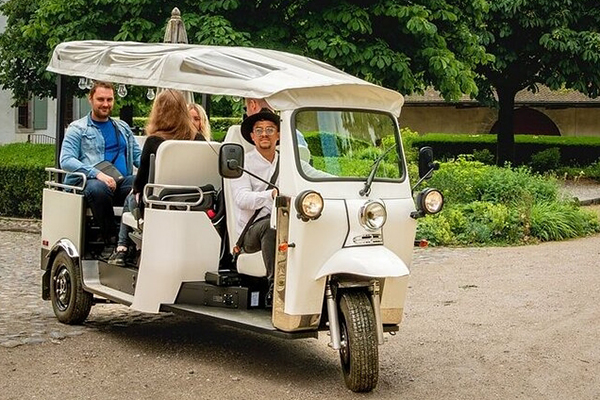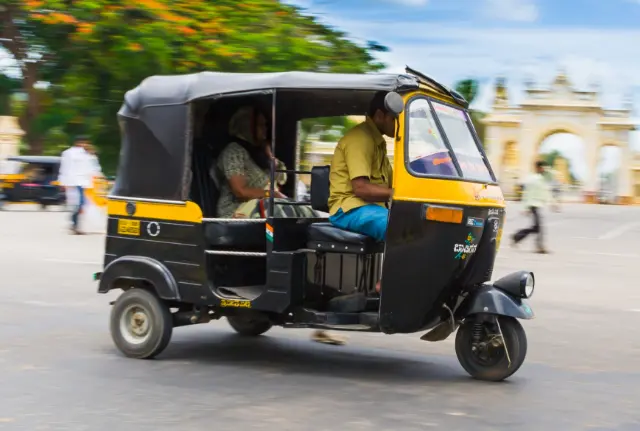The hum of the electric rickshaw is the new sound of urban mobility. As a manufacturer specializing in these incredible vehicles, I’ve seen the e rickshaw evolve from a niche product into a global force for efficient, clean transportation. Whether you call it an e rickshaw, an electric auto, or a battery operated rickshaw, this versatile three wheeler is changing how people and goods move, from the bustling streets of India to last-mile delivery routes in the USA.
For a business owner or fleet manager, understanding this market is key to making a smart investment. This guide is your roadmap. We’ll break down everything from what drives the rickshaw price to how to find a reliable rickshaw manufacturer. We will explore different models, from a passenger taxi to a heavy-duty cargo loader, and compare popular options like the Mahindra e rickshaw with high-quality models from a dedicated factory. Let’s get you ready to build your fleet.
What is the Difference Between an E Rickshaw and a Traditional Auto Rickshaw?
At first glance, the modern e rickshaw and the classic auto rickshaw serve a similar purpose: they are compact three wheeler vehicles designed for urban transport. However, what powers them creates a world of difference. The traditional auto rickshaw runs on a noisy, polluting internal combustion engine. The electric rickshaw, on the other hand, is powered by a quiet, efficient electric motor and a rechargeable battery pack. This fundamental change is why the e rickshaw is a superior vehicle for modern commercial use.
The benefits of going electric are immediate. First, the operational cost of an e rickshaw is a fraction of its gas-guzzling cousin. Charging a battery is significantly cheaper than buying fuel, leading to higher profits for your business. Second, the maintenance is far simpler. An electric motor has very few moving parts compared to a combustion engine, meaning less downtime and fewer repair bills. Finally, the ride experience is transformed. The quiet, vibration-free journey is more pleasant for both the driver and the passenger, and the zero-emission profile makes it an eco-friendly choice for any city. This isn’t just a new type of rickshaw; it’s a better one.
Why is the Battery Operated Rickshaw Market Booming in India?
The rise of the battery operated rickshaw in India has been nothing short of a revolution. Cities across the country, from Delhi to Kolkata, have embraced these vehicles as a solution to traffic congestion and air pollution. The e rickshaw has become the backbone of last-mile connectivity, linking metro stations to neighborhoods and providing an affordable and accessible mode of transportation for millions. The government of India has actively supported this shift with subsidies and favorable policies, accelerating the adoption of this green vehicle.
Major domestic brands like Mahindra have entered the market, with models such as the Mahindra Treo Yaari becoming a common sight. The success of the e rickshaw in India is a powerful case study for the rest of the world. It proves that this vehicle is not just environmentally friendly but also economically viable, creating jobs for drivers and business opportunities for fleet owners. The e rickshaw has demonstrated its ability to thrive in one of the most demanding markets, showcasing its durability and efficiency. The lessons learned in India are now being applied globally as more regions look to the e rickshaw as a smart mobility solution.

What Key Specifications Determine the Price of an Electric Rickshaw?
When you start shopping for an e rickshaw, you’ll see a wide range of prices. Understanding what influences the final price is crucial to avoid overpaying or, worse, buying a low-quality vehicle that won’t last. The rickshaw price is a direct reflection of its components and build quality. As a manufacturer, I always tell my clients to look beyond the sticker price and examine the core specifications.
Here’s a breakdown of what drives the cost of an e rickshaw:
| Component | Impact on Price | Why It Matters for Your E Rickshaw |
|---|---|---|
| Battery Type & Capacity | Very High | This is the biggest cost factor. A high-capacity Lithium-ion battery costs more than a lead-acid one but offers a much longer life, faster charging, and greater range (km). The battery is the fuel tank of your e rickshaw. |
| Motor Power | High | A more powerful motor provides better acceleration and hill-climbing ability, especially important for a fully loaded passenger or cargo rickshaw. A superior motor ensures reliable performance. |
| Controller Quality | Medium | The controller is the brain of the e rickshaw. A high-quality controller delivers power smoothly, protects the battery and motor, and improves overall efficiency. |
| Chassis & Build Materials | Medium | The quality of the steel frame, the thickness of the body, and the durability of the suspension directly impact the vehicle‘s safety and longevity. This is where some cut corners to lower the price. |
| Features & Warranty | Low-Medium | Extras like a digital display, quality seating, and a comprehensive warranty add to the price but also add significant value and peace of mind. |
A cheaper e rickshaw often uses a lower-capacity lead-acid battery and a less powerful motor, which will ultimately cost you more in frequent replacements and poor performance. The best price is one that gets you a durable, reliable vehicle.
How Do You Choose the Right Battery and Motor for a Commercial E Rickshaw?
The engine room of your electric rickshaw is its battery and motor. Making the right choice here is critical for the success of your commercial operation. You need a powertrain that can handle the daily grind without failing.
For the battery, the choice is between older lead-acid technology and modern Lithium-ion. While lead-acid has a lower initial price, it’s heavy, has a short lifespan (fewer charge cycles), and requires maintenance. For a commercial vehicle that runs all day, a Lithium-ion battery is the only logical choice. It’s lighter (improving range), lasts 3-5 times longer, and is virtually maintenance-free. The higher upfront cost is easily recovered through its superior longevity and performance. The battery capacity, measured in Ampere-hours (Ah), will determine how many km your rickshaw can travel on a single charge.
The motor is equally important. The power of the motor (measured in Watts) dictates the rickshaw‘s acceleration and its loading capacity. A passenger e rickshaw might use a 1000W-1500W motor, which is plenty for city routes. However, a cargo loader rickshaw designed to carry heavy goods will need a more powerful and robust motor to handle the strain. Always match the motor specification to your intended use to ensure your e rickshaw fleet is both powerful and efficient.
Passenger vs. Cargo: Which Three Wheeler E Rickshaw Model is Right for Your Business?
The electric rickshaw is an incredibly versatile platform. The two main categories you’ll encounter are the passenger e rickshaw and the cargo e rickshaw, also known as a loader. Your business model will dictate which vehicle you need.
A passenger e rickshaw is essentially an electric taxi. The design prioritizes comfort and safety for the occupants. Key features include:
- Seating Capacity: Most are a 4 seater model, though some can be larger. The seat design should be spacious and comfortable.
- Cabin and Body: A sturdy roof and a semi-enclosed cabin protect passengers from the elements. Our popular EV5 Electric passenger tricycle is a perfect example of a passenger-focused design.
- Smooth Ride: Superior suspension is a must to ensure a comfortable journey for every passenger.
A cargo e rickshaw or loader, on the other hand, is a pure workhorse. The focus is on durability and loading capacity.
- Loading Bay: This can be an open body flatbed for versatile loads or an enclosed box for security, like our Van-type logistics electric tricycle HPX10.
- Heavy-Duty Build: The chassis, suspension, and wheel assembly are reinforced to handle heavy loads, often with a specified loading capacity of 500kg or more.
- Functionality: The design is practical, prioritizing ease of loading and unloading over passenger comforts.
Many businesses, especially in logistics, require a dedicated cargo e rickshaw fleet to handle last-mile deliveries efficiently.

How Can You Find and Vet a Reliable E Rickshaw Manufacturer or Supplier?
Finding a trustworthy rickshaw manufacturer is perhaps the most critical step in the buying process. A great product is useless without a reliable supplier to back it up. For international buyers, this can seem daunting, but a structured approach makes it manageable.
Start by looking for an established factory with export experience, not just a local trading company. A true manufacturer of electric rickshaws will have control over the manufacturing process, from raw materials to final assembly. Here’s how to vet a potential supplier:
- Ask for Credentials: Request their business license, export license, and any quality certifications (like ISO 9001). A legitimate factory will provide these readily.
- Inquire About Their Main Markets: A supplier with experience exporting to Europe or North America likely adheres to higher quality and safety standards than one that only sells locally.
- Discuss Production Capacity: Can they handle your order size? Do they have dedicated lines for different e rickshaw models?
- Request a Sample: Before placing a large order, arrange to inspect a sample vehicle. This allows you to assess the build quality, materials, and finish firsthand.
- Evaluate Communication: A professional supplier from China or elsewhere will communicate clearly and promptly. Poor communication before the sale is a major red flag for after-sales support.
While local dealership networks exist in places like India for brands like Mahindra, buying direct from a factory often provides a better price and more control over the final product.
Is it Possible to Customize or Upgrade an Electric Auto Rickshaw?
Absolutely. One of the biggest advantages of working directly with an e rickshaw factory is the ability to customize your vehicles. Standard, off-the-shelf models are great, but a custom e rickshaw can be tailored to the specific needs of your business, giving you a competitive edge.
Customization can range from simple branding to significant structural changes. Common requests we get at our factory include:
- Branding: We can produce your electric auto rickshaw fleet in your company colors and add your logos. This turns every rickshaw into a mobile billboard.
- Battery Upgrade: You can often choose a battery with a higher capacity to extend the range (km) of your vehicle. This is a popular upgrade for delivery fleets.
- Cargo Box Modification: For a loader rickshaw, the cargo area can be fully customized with shelving, refrigeration units, or specific locking mechanisms.
- Seating and Cabin: The passenger seat layout can be modified, or you can add extra safety features like doors or stronger grab rails.
Even a mini electric auto can be customized for specific tasks. Don’t hesitate to discuss your needs with the manufacturer. A good partner will work with you to build the perfect e rickshaw model for your operation.

What Should You Look for in the Specification and Warranty of an E-Rickshaw?
The specification sheet and the warranty are your best friends when evaluating an e-rickshaw. These documents tell you exactly what you’re buying and what level of protection you have if something goes wrong. Don’t just glance at them; read them carefully.
On the specification sheet, look for these key details:
- Battery: Type (Lithium-ion is best), Voltage (V), and Capacity (Ah). This determines range and power.
- Motor: Power rating (W) and type (Brushless DC is standard).
- Range: The estimated distance in km on a single charge. Be aware this is usually under ideal conditions.
- Loading Capacity: Crucial for both cargo and passenger models. It tells you the maximum weight the rickshaw can safely carry.
- Dimensions & Weight: Important for storage and navigating tight spaces.
- Wheel and Tire Size: A larger three wheel setup can offer a smoother ride.
The warranty is your safety net. A reliable manufacturer will offer a comprehensive warranty. Look for at least a one-year warranty on the main components, including a separate, often longer, warranty for the battery and motor. A clear warranty policy shows that the supplier stands behind their product.
The Mahindra E Rickshaw vs. Sourcing from a Factory in China: What’s the Better Deal?
For businesses in India, a local brand like Mahindra is a strong and visible option. Mahindra e rickshaws, including popular models like the Mahindra Treo, are widely available through an extensive dealership network. They offer the convenience of local service and a known brand name. This is a solid choice for small-scale buyers within India.
However, for a business owner building a larger fleet, especially an international one, sourcing directly from a specialized factory in China presents a compelling alternative. The primary advantages are price and customization. By cutting out the middleman, you can get a significantly better price per vehicle. Furthermore, as discussed, a factory can customize the e rickshaw to your exact specifications—something a mass-market brand like Mahindra typically cannot do.
We build our e-rickshaws with high-quality materials intended for demanding global markets. While a Mahindra e rickshaw is built for the Indian market, our vehicles are designed to meet diverse international standards. For a buyer focused on getting the best value, highest quality, and a vehicle perfectly tailored to their needs, a leading manufacturer from China is often the more strategic business decision.
What is the Future for Commercial Electric Tricycle and E-Rickshaws?
The future of the electric rickshaw is incredibly bright. This is not a passing trend; it’s a fundamental shift in urban logistics and transportation. We are seeing rapid innovation in battery technology, with new chemistries promising even longer ranges and faster charging times. The e-rickshaws of tomorrow will be smarter, safer, and even more efficient.
We can expect to see more integration of technology, such as GPS tracking for fleet management and digital payment systems built directly into the passenger cabin. Safety features will continue to improve, with better braking systems and more robust frame designs becoming standard. The commercial applications will also expand. We are already seeing specialized e-rickshaws for everything from refrigerated food delivery to mobile waste collection. The electric tricycle platform is proving to be one of the most adaptable forms of commercial electric vehicle.
From its roots as a simple passenger rickshaw in Asia, the e rickshaw is now a global phenomenon. It offers a powerful combination of affordability, efficiency, and eco-friendly performance that is unmatched by any other vehicle in its class. For any business involved in moving people or goods in a city, the electric auto rickshaw is no longer just an option; it’s the future.
Key Takeaways
- Go Electric: An e rickshaw offers lower running costs, less maintenance, and a better experience than a traditional auto rickshaw.
- The Battery is Everything: Prioritize a high-quality Lithium-ion battery. It’s the most important component determining the vehicle’s range, lifespan, and overall price.
- Choose the Right Model: Decide if you need a passenger rickshaw (like a 4 seater taxi) or a cargo loader rickshaw based on your business needs.
- Vet Your Supplier: A reliable rickshaw manufacturer is key. Look for a factory with export experience and a commitment to quality over just a low price.
- Don’t Be Afraid to Customize: Working directly with a manufacturer allows you to build the perfect e rickshaw for your brand and operational needs.
- Read the Fine Print: Pay close attention to the specification sheet and warranty to ensure you are buying a quality vehicle backed by the supplier.
Post time: 11-06-2025




